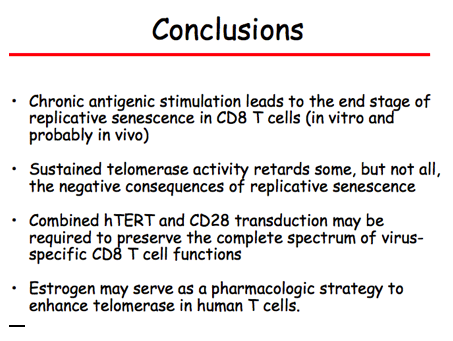| |
Immune Exhaustion in Aging and AIDS: Parallel Mechanisms and Possible Solutions
|
| |
| |
CROI 2008
Rita Effros
David Geffen Sch of Med, Univ of California, Los Angeles, US
"These telomerase-based approaches, and others involving maintenance of CD28 expression, may lead to practical therapeutic strategies for preventing immune exhaustion in both young and progressively increasing population of older HIV-infected persons."
Background: The cohort of individuals infected with HIV-1 is progressively aging, due, in large part, to the prolonged survival resulting from ART. HIV disease is comprised of several immune system changes that mirror those occurring during normal aging, suggesting possible synergistic immunological defects in older HIV+ individuals, consistent with the observed age-related, accelerated HIV disease progression. One of the salient features of the aging immune system, in the absence of HIV, is the accumulation of clonal expansions of CD8+ T cells with features of replicative senescence, including reduced proliferative capacity and effector function, shortened telomeres, loss of telomerase activity, absence of the CD28 co-stimulatory receptor, and altered cytokine profiles. Many of these T cells are specific for latent herpes viruses, particularly cytomegalovirus (CMV), suggesting that long-term maintenance of immunity to persistent viruses leads to the accumulation of dysfunctional virus-specific cells, which fail to be eliminated from the system. In the elderly, high proportions of senescent CD8+ T cells are associated with poor vaccine responses, osteoporotic bone disease, and early mortality. In HIV-infected persons, both CMV and HIV-specific CD8+ T cells have also undergone extensive cell division, as indicated by their shortened telomeres, reduced antiviral function, and absence of CD28.
Methods: To address the problem of CD8+ T cell exhaustion in both aging and AIDS, our laboratory has tested several approaches to retard or prevent the process of replicative senescence.
Results: Experiments using gene transduction of CD8+ T cells from HIV-infected persons have provided proof-of-principle demonstration that maintenance of high constitutive telomerase activity is associated with increased proliferative potential, telomere length stabilization, and augmented anti-viral activity, with no evidence of karyotypic changes. Similar effects are seen following exposure to a small-molecule telomerase activator, TAT2, which leads to significant increases in proliferation, production of anti-viral cytokines/chemokines, and capacity to limit viral production by HIV-infected autologous CD4+ T cells.
Conclusions: These telomerase-based approaches, and others involving maintenance of CD28 expression, may lead to practical therapeutic strategies for preventing immune exhaustion in both young and progressively increasing population of older HIV-infected persons.
Preventing Replicative Senescence in HIV-specific CD8 T Cells
2005 CROI
Rita Effros*1,2, M Dagarag3, S Fauce3, R Marcsisin3, and J Man3
1Geffen Sch of Med, Univ of California, Los Angeles, USA; 2Univ of California, Los Angeles, AIDS Inst, USA; and 3Geffen Sch of Med, Univ of California, Los Angeles, USA
Background: Chronic stimulation of CD8 T cells with antigen in cell culture leads to replicative senescence, an end-stage phenotype characterized by irreversible cell cycle arrest, loss of expression of the CD28 co-stimulatory molecule, altered cytokine profiles, resistance to apoptosis, shortened telomeres, and inability to up-regulate telomerase. Cells with similar characteristics accumulate progressively in persons chronically infected with HIV, in support of the hypothesis that manipulation of replicative senescence may retard the functional decline of CD8 T cells and delay the progression to AIDS. Our proof-of-principle experiments may lead to novel immunotherapy approaches for HIV disease.
Methods: HIV-specific CD8 T cells isolated from persons chronically infected with HIV were either transduced with hTERT (the gene for the catalytic component of human telomerase), or were treated with specific chemicals known to up-regulate telomerase in other cell types. Growth characteristics, telomere length, telomerase activity, function, and karyotype were analyzed.
Results: Transduction with hTERT resulted in the continued proliferation of HIV-specific CD8 T cells. The cells required repeated stimulation with antigen and IL-2 to maintain cell division, and showed no change in growth rate. At 25 population doublings, the point at which the control cultures ceased proliferating, the telomere length of the hTERT cultures was 2.6 kb longer than that of the control cultures. The senescence-associated increase in the p16INK4a and p21WAF1 cell cycle inhibitors was prevented, the loss of CD28 expression was significantly retarded, and the production of INF-g was prolonged. Importantly, the production of soluble factors that inhibit HIV replication in vitro was enhanced by as much as 100-fold in the transduced cultures. Since the maintenance of high telomerase activity in the transduced cultures was not associated with any karyotypic changes, we also tested the effect of exposing the CD8 T cells to certain compounds with known telomerase-enhancing effects in non-immune cell types (e.g., 17-b-estradiol). Telomerase activity was significantly increased, in some cases by as much as 10-fold, even in T cells isolated from AIDS patients.
Conclusions: Targeted genetic or chemical manipulation of telomerase constitutes a potential approach for preventing the functional and phenotypic changes associated with CD8 T-cell exhaustion in HIV disease.

|
|
| |
| |
|
|
|